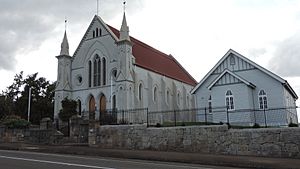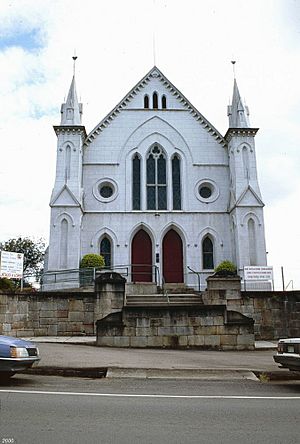Surface Hill Uniting Church facts for kids
Quick facts for kids Surface Hill Uniting Church |
|
|---|---|

Surface Hill Uniting Church, 2015
|
|
| Location | Channon Street, Surface Hill, Gympie, Gympie Region, Queensland, Australia |
| Design period | 1840s - 1860s (mid-19th century) |
| Built | 1869 - 1937 |
| Architect | Hugo William Du Rietz |
| Official name: Surface Hill Uniting Church, City Church, Surface Hill Methodist Church, Wesleyan/Wesley Church | |
| Type | state heritage (built, landscape) |
| Designated | 30 May 2003 |
| Reference no. | 601529 |
| Significant period | 1860s, 1890s, 1930s (historical) ongoing (social) |
| Significant components | church, stained glass window/s, garden/grounds, memorial - honour board/ roll of honour, views to, wall/s - retaining, furniture/fittings, hall |
| Builders | J McMorrine |
| Lua error in Module:Location_map at line 420: attempt to index field 'wikibase' (a nil value). | |
Surface Hill Uniting Church was a historic church building. It stood on Channon Street in Surface Hill, Gympie, Queensland, Australia. An architect named Hugo William Du Rietz designed it. The church was built between 1869 and 1937. People also knew it as City Church or Surface Hill Methodist Church. It became a protected heritage site on May 30, 2003.
History of the Church
The Surface Hill Uniting Church building was finished in 1890. It was the third church built on this important spot in Gympie. In August 1868, a group called the Wesleyan Methodists put up a simple hut. This hut, made of bark and poles, was their first chapel. They were quick to set up a place of worship after gold was found in 1867.
Early Buildings
Even while building the bark hut, the Methodists planned a bigger church. They decided to build it on the same land. A local architect, Charles G. Smith, drew the plans for a timber church. The building was finished and opened on July 4, 1869. It faced Reef Street. Soon after, a small three-room house for the minister was built nearby.
There was a problem with the land title for a while. The church was built on land without proper ownership papers. Church members bought the land in 1869. It was set aside for the church in 1874. But it wasn't officially owned until 1876. This was because the land was under "Miner's Right" rules. Mining was still happening all over Surface Hill. Sometimes, the church even had to pay to fill in old mine shafts for safety.
Growth and a New Brick Church
In 1870, the church got its first full-time minister. Two rooms and a verandah were added to the minister's house. By 1879, the house was old and falling apart. So, people started raising money for a new one. The new house was finished in 1880.
In 1889, Mathew Mellor, an important church member, suggested building a new brick church. This new church would be big enough for 250 people. Many members had wanted a stronger church for years. It showed that Gympie was a strong, growing town. People had faith in the future and wanted to build something lasting. Other churches in town also built stone churches around this time.
Designing the New Church
Local Gympie architect Hugo Du Rietz was chosen to design the new church. He showed his plans to the church leaders in July 1889. Du Rietz was born in Sweden and came to Australia in 1852. He lived in Gympie from about 1867 until he passed away in 1908.
He designed many buildings in Gympie. He was known for special features like curved verandah roofs. He also used a unique color scheme of cream walls and red roofs. The new church was meant to be strong but simple. It would be made of brick and covered in concrete. It would have Gothic style details. A builder named J. McMorrine won the contract to build it for £1905.
Building and Opening
Many celebrations marked the start of the new church. A special stone-laying ceremony happened on January 30, 1890. Eight large foundation stones were laid by important people. These included church members, a local preacher, and a Sunday school student.
Under the first stone, they placed an earthenware jar. Inside were copies of local newspapers and church papers. There was also a list of church leaders and Sunday school teachers. The architect's and builder's names were also included. Each person who laid a stone received a special wooden hammer with a silver plate. One of these hammers is now in the Gympie Historical Museum.
On August 7, the church officially opened with a dedication service. A beautiful organ was bought from James Lord. He was the organist at the Albert Street Methodist Church. This organ, and the one at Albert Street, were made in England in 1888. The total cost of the building was £3137. This included seating, the organ, gas lights, and even lightning conductors.
Later Changes and Sale
The old timber church was updated and used as the Sunday School. The Methodist Church remained strong in Gympie. Church news was often in the local newspaper. In 1904, a minister spoke to Chinese members in their own language. This event attracted many people.
Small repairs were done over the years. But major work didn't happen until the 1930s. In 1937, the church asked the government for help. They used workers from a "relief labour" program to build a stone wall. This wall was along Reef and Channon Streets. The church provided the stone, and the government paid the workers.
The wall took over 18 months to build. It was opened by Frank Cooper, the Queensland Treasurer. He said the wall would remind people of honest work and upholding ideals. These workers also built a tennis court and paths. In the same year, the old church building (now the hall) was moved to face Barter Street.
A new two-story hall was built in 1962. The timber minister's house was taken down in 1975. A new brick building replaced it. From 1977 to 1984, the church was restored. This included work on the stained glass windows and the organ. Ramps were also added for easier access.
In April 2013, the church was sold to a local funeral director. The last church service was held on April 7, 2013.
What the Church Looks Like
The Surface Hill Uniting Church building is made of brick and covered in cement. It sits with other church buildings on Surface Hill in Gympie. The site also has a timber hall (the first church from 1869). There is also a hall from 1962 and a brick minister's house from 1975.
The church building has a simple Gothic style. It uses Gothic designs but is not overly fancy. The front of the church (facing the street) is the most decorated. It has towers at each corner and special windows. The church is shaped like a rectangle. It has six sections, separated by strong supports called buttresses. Each section has a tall, narrow window. The roof is steep and made of corrugated steel.
Inside the Church
The inside of the church is also covered in cement. It has decorative edges and designs around the windows. Columns with fancy tops mark each section inside. The high ceiling is vaulted and made of timber. It has wooden ribs and decorative ceiling roses. Lights and fans hang from the ceiling.
The tall, narrow windows have diamond-patterned leadlight glass in light colors. The front wall has four similar windows high up. These are flanked by two round stained glass windows. Most windows now have aluminum frames.
You enter the church through two doors. These lead into a small porch-like area. This area is made of dark stained timber. An "Honour Roll" (a list of names) is here. There is also a noticeboard and wooden cabinets with leadlight doors.
The main part of the church has a sloped timber floor. The wooden pews (church benches) have been restored. The side aisles are carpeted. At the front, there is a raised platform with low timber rails. This area has a simple timber altar and chairs for elders. A hexagonal timber pulpit (where the preacher stands) is on the left. It has a wooden symbol of the Uniting Church.
A new timber screen separates the choir area and organ loft. Doors on either side of this screen lead to the choir and exit doors. A small library and sink are on the eastern side. A vestry (a room for changing clothes) is on the west.
The Organ
The beautiful organ is a standout feature inside. Its pipes are hand-painted in shades of blue with cream and gold. The organ is framed by a special section of the wall. This section has a molded edge and a pointed arch at the top. It is painted tan against the cream walls.
Other Buildings and Walls
The old church building is now a hall. It is used for church and community events. It also houses the church office. It is a small timber building with a steep roof and a small porch. It sits on short concrete stumps. The walls are made of weatherboards. The windows are multi-paned with pointed tops.
The inside of the hall has horizontal timber lining. It has an open ceiling with exposed timber trusses. A raised stage is at the back of the hall. Timber floors are throughout. The office is in a separate part of the building.
The church property has a stone retaining wall along some streets. This wall is made of rough, unsorted stones. A concrete staircase is built into the wall. This provides access to the church.
Why It's a Heritage Site
Surface Hill Uniting Church was added to the Queensland Heritage Register on May 30, 2003. It met several important criteria.
Showing History
The church, built in 1890, shows how Queensland's history unfolded. It represents Gympie's fast growth. It also shows how religious and social groups developed there. This happened in the 1880s and 90s because of the gold rush. The church also shows how the Methodist Church grew in regional Queensland. It highlights how local communities worked to meet their spiritual needs.
Rare Features
The Benson organ inside the church is rare. It is one of only two such organs in Queensland. It is a special example because of its age and how it was made. It has also kept its original design and sound.
The stone retaining wall along Reef and Channon Streets is important. It is an example of work done by "relief labour." This was part of a program between the church and the government during the Great Depression.
The Surface Hill Uniting Church is a good example of church architecture from the late 1800s. It also shows the work of Hugo Du Rietz.
Beauty and Landmark Status
The church is very beautiful. It has been an important landmark in Gympie since it was built. It is an impressive building on a noticeable hill. It is one of several churches located on the hills of Gympie. The simple and attractive inside has many special features. The beautiful organ with its hand-painted pipes is especially noteworthy.
Community Connection
Surface Hill Uniting Church has a strong connection with the Wesleyan Methodist group in Gympie. It was their main place of worship for over 130 years. It holds great spiritual and social meaning for the community.
Important People
The church has a special connection with Hugo Du Rietz. He was a local Gympie architect. He made a big impact on the look and feel of the town's buildings.




